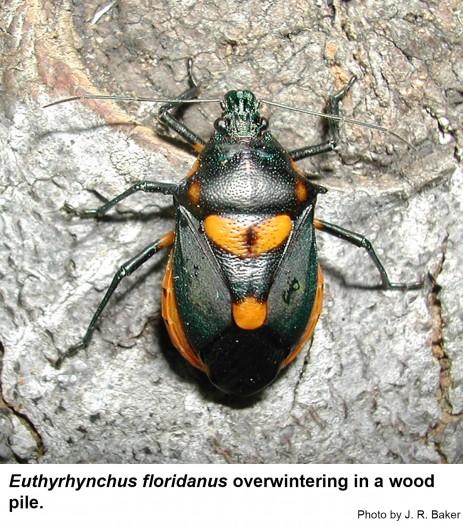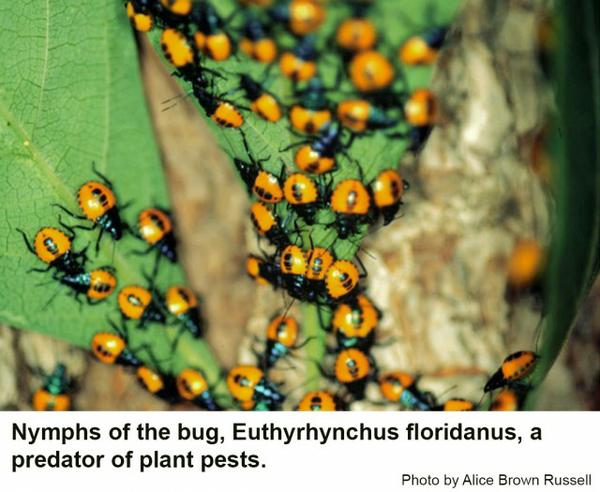Description and Biology
Indeed, Euthyrhynchus floridanus, the Florida predatory stink bug, is a stink bug, but it is considered beneficial because it feeds on plant pests. Adults have orange spots on a dark, metallic blue background. This insect overwinters as adults in wood piles or some other dry, sheltered location. Eggs are laid the following spring and hatch 19 to 33 days later. Nymphs of Euthyrhynchus floridanus develop slowly through five stages (40 to 67 days). New females wait 5 or 6 days before mating and eggs are laid 23 to 67 days later. Total developmental time for this species is much longer than for plant-feeding stink bugs. Immature Euthyrhynchus have a strong tendency to aggregate, and they even attack larger prey in concert. Apparently, aggregation behavior allows them to successfully attack prey too large to be subdued by a single nymph. Sometimes adults aggregate with nymphs, although when times get hard, these bugs sometimes feed on smaller relatives! When the bugs jab their proboscis into a less fortunate insect, they inject a toxin that slowly immobilizes the prey. The predigested insides are then sucked out. Euthyrhynchus bugs have an unusual "wagging" behavior in which the bug rocks its body from side to side while it grips the substrate firmly with its feet. This is thought to be a defensive behavior.
Hosts
The Florida predatory stink bug is considered a beneficial insect because most of its prey consists of plant-damaging bugs, beetles, and caterpillars. It seldom plays more than a minor role in the natural control of insects, but its prey includes a number of economically important species. This bug is found occasionally on just about any plant in the landscape. It may feed facultatively on plants but never causes noticeable damage.
Residential Recommendation
Plant damage has never been noted for Euthyrhynchus stink bugs. If such feeding does occur, the negligible plant damage is certainly outweighed by their beneficial role in controlling plant feeding pests. Most bugs are susceptible to Sevin insecticide, but in this case, it does not seem to be necessary to treat since the Florida predatory stink bug is way more beneficial than harmful.
References
- Common name: Florida predatory stink bug (suggested common name), scientific name: Euthyrhynchus floridanus (Linnaeus) (Insecta: Hemiptera: Pentatomidae). Mead, F. W. and D. B. Richman. 2016 (revised). Featured Creatures. Entomology & Nematology, DACS/DPI, EDIS Pub. No. EENY-157.
- Comparative life cycles of four species of predatory stink bugs. Richman, D. B. and W. H. Whitcomb. 1978. Florida Entomologist 61(3): 113-119.
- Species Euthyrhynchus floridanus - Florida Predatory Stink Bug. Coin, P. et al. (2018 update). BugGuide, Iowa State University, Dept.
- Extension Plant Pathology Publications and Factsheets
- Horticultural Science Publications
For assistance with a specific problem, contact your local N.C. Cooperative Extension Center.
This Factsheet has not been peer reviewed.
Publication date: Nov. 26, 2012
Reviewed/Revised: May 4, 2023
N.C. Cooperative Extension prohibits discrimination and harassment regardless of age, color, disability, family and marital status, gender identity, national origin, political beliefs, race, religion, sex (including pregnancy), sexual orientation and veteran status.


